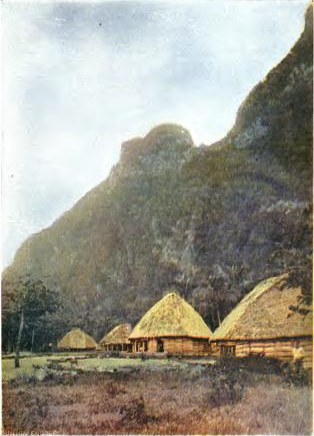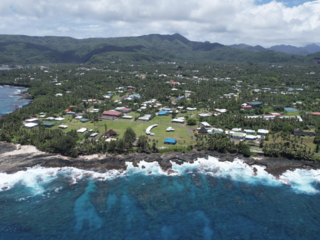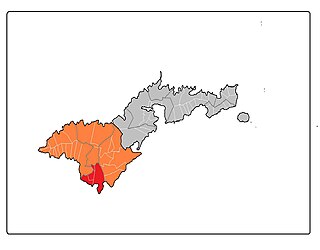Related Research Articles
In the United States, each state has its own written constitution.

Tutuila is the largest and most populous island of American Samoa and is part of the archipelago of the Samoan Islands. It is the third largest island in the Samoan Islands chain of the Central Pacific. It is located roughly 4,000 kilometers (2,500 mi) northeast of Brisbane, Australia and lies over 1,200 kilometers (750 mi) to the northeast of Fiji. It contains a large, natural harbor, Pago Pago Harbor, where Pago Pago, the capital of American Samoa, is situated. Pago Pago International Airport is also located on Tutuila. The island's land expanse is about 68% of the total land area of American Samoa. With 56,000 inhabitants, it is also home to 95% of the population of American Samoa. The island has six terrestrial and three marine ecosystems.

The Tripartite Convention of 1899 concluded the Second Samoan Civil War, resulting in the formal partition of the Samoan archipelago into a German colony and a United States territory.

The islands of Samoa were originally inhabited by humans as early as 850 BC. After being invaded by European explorers in the 18th century, by the 20th and 21st century, the islands were incorporated into Samoa and American Samoa.

The American Samoa Fono is the territorial legislature of American Samoa. Like most states and territorial legislatures of the United States, it is a bicameral legislature with a House of Representatives and a Senate. The legislature is located in Fagatogo along Pago Pago harbor.

The American Samoa Senate is the upper house of the American Samoa Fono. The Senate, like the lower House of Representatives, is a nonpartisan body. It is composed of 18 senators, serving a four-year term.

Benjamin Franklin Tilley was a career officer in the United States Navy who served from the end of the American Civil War through the Spanish–American War. He is best remembered as the first acting governor of American Samoa as well as the territory's first naval governor.

General elections were held in American Samoa on 4 November 2008 to elect a governor, members of the House of Representative, and a delegate to the United States House of Representatives, as well as a referendum on a legislative override of the governor's veto. The elections were held as part of the wider 2008 United States general election.

The following outline is provided as an overview of and topical guide to American Samoa:
The government of American Samoa is defined under the Constitution of American Samoa.
The following table indicates the party of elected officials in the United States insular area of American Samoa:

American Samoa is an unincorporated territory of the United States located in the South Pacific Ocean, southeast of the island country of Samoa. Centered on 14.3°S 170.7°W, it is east of the International Date Line and the Wallis and Futuna Islands, west of the Cook Islands, north of Tonga, and some 500 kilometers (310 mi) south of Tokelau. American Samoa is the southernmost territory of the United States and one of two U.S. territories south of the Equator, along with the uninhabited Jarvis Island.

A constitutional referendum was held in American Samoa on November 2, 2010, on the same day of the United States House of Representatives election and American Samoan general election.
The Treaty of Cession of Tutuila, also known as the Deed of Cession of Tutuila, was a treaty between several chiefs of the island of Tutuila and the United States signed on April 17, 1900, whereby the chiefs swore allegiance to, and ceded the island of Tutuila to, the United States, which now forms part of American Samoa. It came about because of the Second Samoan Civil War and the Tripartite Convention of 1899 between the United States, the United Kingdom, and the German Empire. It was ratified by the United States Congress by the Ratification Act of 1929.
The Treaty of Cession of Manuʻa, also known as the Deed of Cession of Manuʻa, was a treaty between Tui Manuʻa Elisala and the United States signed on 16 July 1904 that ceded the islands of Manuʻa to the United States, which now forms part of American Samoa. It came about because of the Second Samoan Civil War and the Tripartite Convention of 1899 between the United States, the United Kingdom, and the German Empire. It was ratified by the United States Congress by the Ratification Act of 1929.
The Ratification Act of 1929 was joint resolution of the United States Congress that authorized the ratification of the Treaty of Cession of Tutuila of 1900 and the Treaty of Cession of Manu'a of 1904, which ceded the islands of Tutuila and Manu'a, respectively, to the United States and now form part of American Samoa. As such it is one of the basic Constitutional documents of American Samoa. These agreements came about because of the Second Samoan Civil War and the Tripartite Convention of 1899 between the United States, the United Kingdom, and the German Empire.

Vailoatai is a village in southwestern Tutuila, the main island of American Samoa. It is located on the eastern end of Leone Bay. The village is known for its beautiful malae, nested along the island's rugged southern coast and lined by the fale tali mālō of its village chiefs.
Taliutafa Christopher Leiesilika Young, also known as Christopher Taliutafa Young, Chris Young or Kilisi Young was the last claimant to the traditional title Tui Manu'a of Manu'a, a group of islands in the eastern part of the Samoan Islands. He was deposed from this title and exiled by American Governor Edward Stanley Kellogg because the idea of monarchy was incompatible with the Constitution of the United States.

Tuālā-tai County is one of the five counties that make up the Western District of American Samoa.
American Samoa consists of a group of two coral atolls and five volcanic islands in the South Pacific Ocean of Oceania. The first permanent European settlement was founded in 1830 by British missionaries, who were followed by explorers from the United States, in 1839, and German traders in 1845. Based upon the Tripartite Convention of 1899, the United States, Great Britain, and Germany agreed to partition the islands into German Samoa and American Samoa. Though the territory was ceded to the United States in a series of transactions in 1900, 1904, and 1925, Congress did not formally confirm its acquisition until 1929. American Samoans are non-citizen nationals of the United States. Non-citizen nationals do not have full protection of their rights, though they may reside in the United States and gain entry without a visa. Territorial citizens do not have the ability for full participation in national politics and American Samoans cannot serve as officers in the US military or in many federal jobs, are unable to bear arms, vote in local elections, or hold public office or civil-service positions even when residing in a US state. Nationality is the legal means in which inhabitants acquire formal membership in a nation without regard to its governance type. Citizenship is the relationship between the government and the governed, the rights and obligations that each owes the other, once one has become a member of a nation.
References
- ↑ Leibowitz 1980, p. 254.
- ↑ Leibowitz 1989, p. 420.
- ↑ Leibowitz 1980, pp. 254–255.
- ↑ Lal, Brij V. and Kate Fortune (2000). The Pacific Islands: An Encyclopedia, Volume 1. University of Hawaii Press. Page 560. ISBN 9780824822651.
- ↑ "Our District". 3 January 2021.
- ↑ "Congressional Record Extensions of Remarks Articles".
- ↑ Sunia, Fofō I. F. (1998). The Story of the Legislature of American Samoa: In Commemoration of the Golden Jubilee 1948-1998. Pago Pago, AS: Legislature of American Samoa. Page 273. ISBN 9789829008015.
- ↑ Leibowitz 1989, p. 423.
- ↑ Pub. L. 98–213 , 97 Stat. 1459 , enacted December 8, 1983, § 12 at 97 Stat. 1462, codified at 48 U.S.C. § 1662a
- ↑ U.S. Government Accountability Office (September 18, 2008). American Samoa: Issues Associated with Some Federal Court Options (PDF) (Report). U.S. Government Accountability Office.
- Leibowitz, Arnold H (1980). "American Samoa: Decline of a Culture". California Western International Law Journal . 10: 220–271.
- Leibowitz, Arnold H (1989). Defining Status: A Comprehensive Analysis of United States Territorial Relations. ISBN 978-0-7923-0069-4.